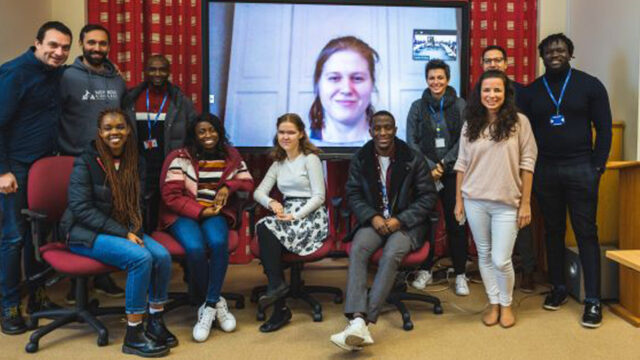Scott Garrett, division corporate responsibility officer for the AdventHealth West Florida Division in the United States, had tried losing weight and staying healthy […]

Scott Garrett, division corporate responsibility officer for the AdventHealth West Florida Division in the United States, had tried losing weight and staying healthy many times before. But like many others, he found himself quickly stumbling along the way. Millions of people set new goals every year in an effort to prioritize a healthier lifestyle. But, as Garrett found out, these goals can often be forgotten or set aside almost as soon as they are established.
While the end of another year looms closer, it’s not too late to start building lifelong positive habits. But a healthier lifestyle is more than just eating fruits and vegetables or moving your body every day. Making healthy lifestyle changes permanent often requires a mindset shift as well.
Garrett recently experienced the benefits of this mindset shift by using the tools he learned through AdventHealth’s Wondr Health program, a digital behavioral change program that teaches weight management skills. Wondr Health is available as a free benefit to all AdventHealth team members. The program focuses on behavior modification and mindfulness while eating. With these important tools, Garrett learned how to determine when he was hungry and when he was full. Making and sticking with his new habits resulted in a positive change in his weight and his relationship with food.
“Things were headed down a bad road before, and now they are under control,” Garrett said. And he feels confident he can stay in control. “I feel great, and the weight loss is great too.”
Garrett’s most significant weight loss occurred during his first three weeks in the program, when he avoided any added sugar. With time he successfully lost more than 50 pounds (22.5 kilograms). While the rate of weight loss eventually slows down, Garrett says he is okay with that, and his doctors are too. After completing the six-month program, his blood pressure and blood sugar levels had also improved.
Through the Wondr Health program Garrett learned about the importance of avoiding certain foods, and he experienced a change in his relationship with food. “You don’t crave sugar or a lot of carbohydrates as much. You learn to taste again, how to savor the flavor of your food,” Garrett said. With these simple lifestyle changes and a shift in his mindset, he was able to lose the weight and keep it off.
A Wholistic Approach to Lifestyle Changes
Garrett’s story of positive impact from a mindset change, improved nutrition, and exercise is just one example of many that AdventHealth physicians and specialists have witnessed. But the specific factors hindering a positive lifestyle change can be different from person to person, and identifying those factors is crucial to starting the change.
“In my experience, it’s almost always more than one factor contributing to the patient’s inability to stick with a lifestyle change,” Eric Shadle, vice president of mission integration at Centura Health and a practicing physician for more than 20 years, said. “I have found that most of the time, the patient isn’t aware of what those other factors are.”
Shadle often uses resources like CREATION Life, a faith-based wellness plan developed by AdventHealth, to help his patients identify the underlying factors hindering their ability to commit to change.
The plan is anchored in eight key principles: choice, rest, environment, activity, trust in God, interpersonal relationships, outlook, and nutrition.
“The patient may struggle with outlook or interpersonal relationships that impact the patient’s current behavior,” Shadle said. “Once we identify those contributing factors, we can work toward making lasting change. This form of mindfulness is extremely important. It gives you the tools and awareness to really think about what you’re feeling and how it’s impacting you.”
Setting S.M.A.R.T. Goals
Once the factors are identified, it’s time to develop a plan and set realistic goals for lasting change. When helping patients create a plan, Lisa Markley, director of culinary medicine for the Whole Health Institute at AdventHealth Kansas City, recommends setting S.M.A.R.T. (specific, measurable, achievable, realistic, time-bound) goals.
Specific: “Instead of saying ‘I want to lose weight,’ we might say ‘in order to lose weight, I need to eat more vegetables, specifically salad three days a week.’”
Measurable: “We can write down when and how many days we eat salad.”
Attainable: “Maybe the patient can’t afford the most expensive greens we recommend, but we can help them find something they’re able to get on a regular basis.”
Realistic: “We don’t recommend kale every day if you don’t like kale.”
Time-bound: “This can involve defining a start date. Then we schedule the patient to come back in four weeks to see how they’re moving toward their goals. For example, we could say ‘for the next three weeks, eat salad three times a week, with greens that you like, that you can afford, and that you can make easily.’”
Dealing with Setbacks
It’s also crucial to plan for potential setbacks. Shelly Buehler, nutrition clinic coordinator for the Nutrition and Diabetes Education Center at AdventHealth Shawnee Mission, stresses the importance of a support system.
“Family, friends, spouses, a health coach, or a trainer at the gym,” said Buehler. “Anyone who is really going to give you sound advice and support. Someone who is not going to judge you.”
Buehler also recommends treating each meal as a new opportunity. “We all make mistakes and mess up. Step away from that and say, ‘How could I do it better next time? What are other things I could try?’ Look for opportunities to learn and grow from mistakes. It’s critical to get back on track. I see people who are all-or-nothing. Don’t set the bar at 100 percent, or you’ll get burnt out. No one can be perfect.”
Measuring for Success
While many focus on seeing a certain number on the weight scale, there are other ways success can be measured. “You might measure inches lost in your waist and hips,” Buehler said.
Biometric measurements can also provide great insight on the success of your efforts. “We often look at biomarkers,” Markley said. “Are lab results for cholesterol and triglycerides improving? Do you have increased energy? We look at motivation, mental clarity, inflammation like joint pain, and whether the individual is sleeping better. When you’re nourishing the body well, you can improve many of those factors. For example, maybe someone isn’t losing weight, but they have less bloating, they’re losing inches, they feel less icky, and they have more energy and better digestion.”
Health for Life
“Society puts so much pressure on people to look a certain way and weigh a certain amount, so we really have to change the way we think about healthy eating for life,” Buehler said. “That’s the journey we’re all on from childhood. We all want to maintain our health.”
That long-term maintenance requires something beyond a number on the scale or a short-term victory. “I try to help patients think about their why,” Markley said. “What’s motivating you to make lasting changes? You might not care about your weight—bodies come in all shapes and sizes. But maybe your dietary choices are impacting your ability to play with your grandkids. Maybe your weight is putting a strain on your joints. Or maybe you have other goals like training for a 5K. Think about your why. Then when you have setbacks, you’ll feel more likely to refocus and give yourself some grace.”
The original version of this commentary was posted on the Mid-America Union Conference Outlook.









